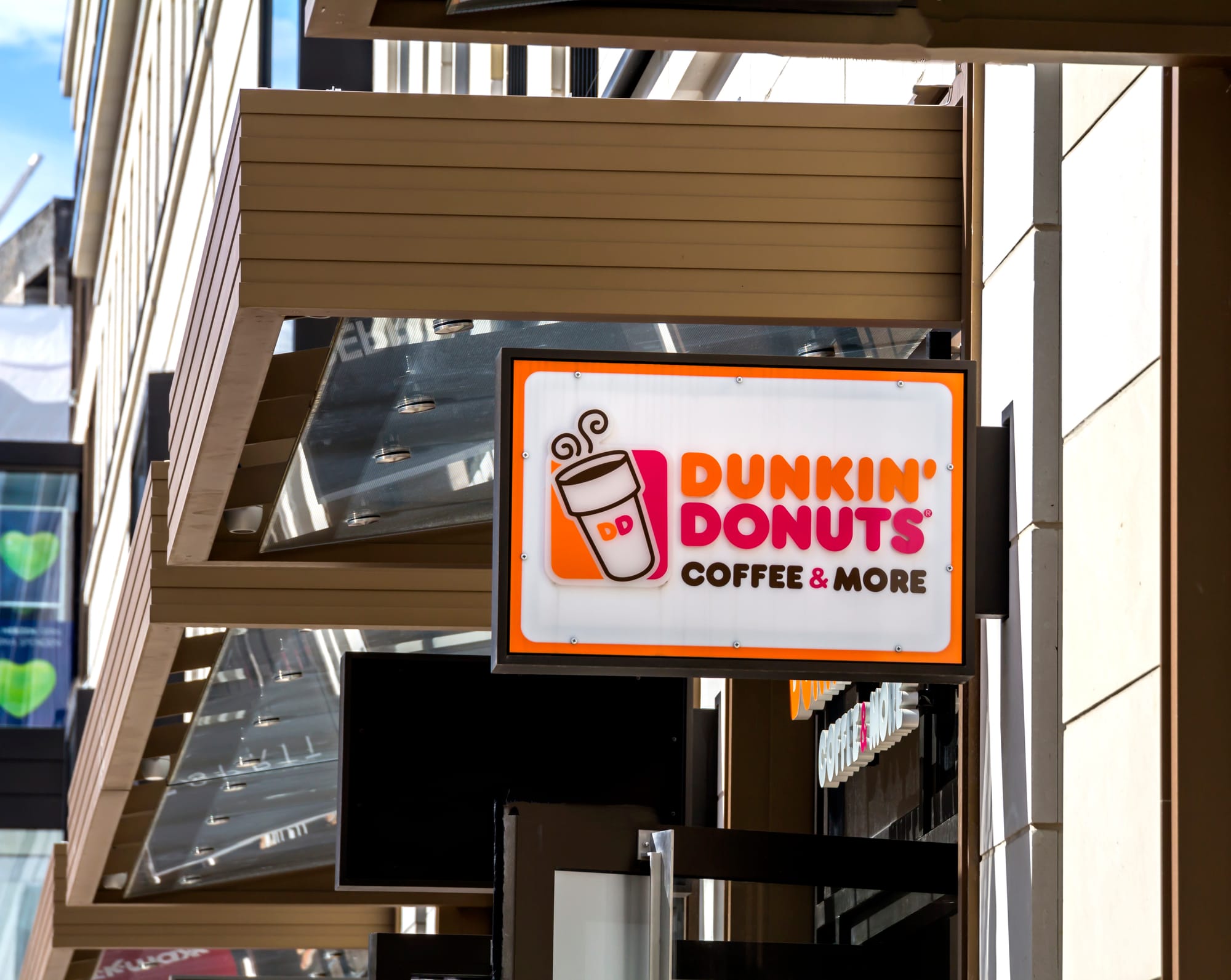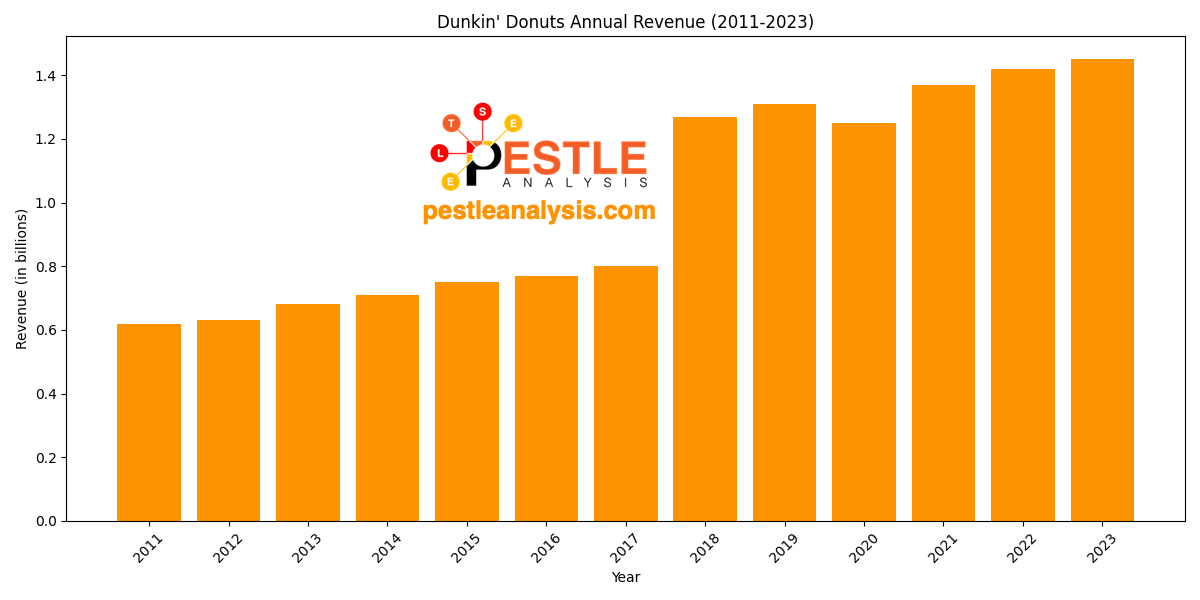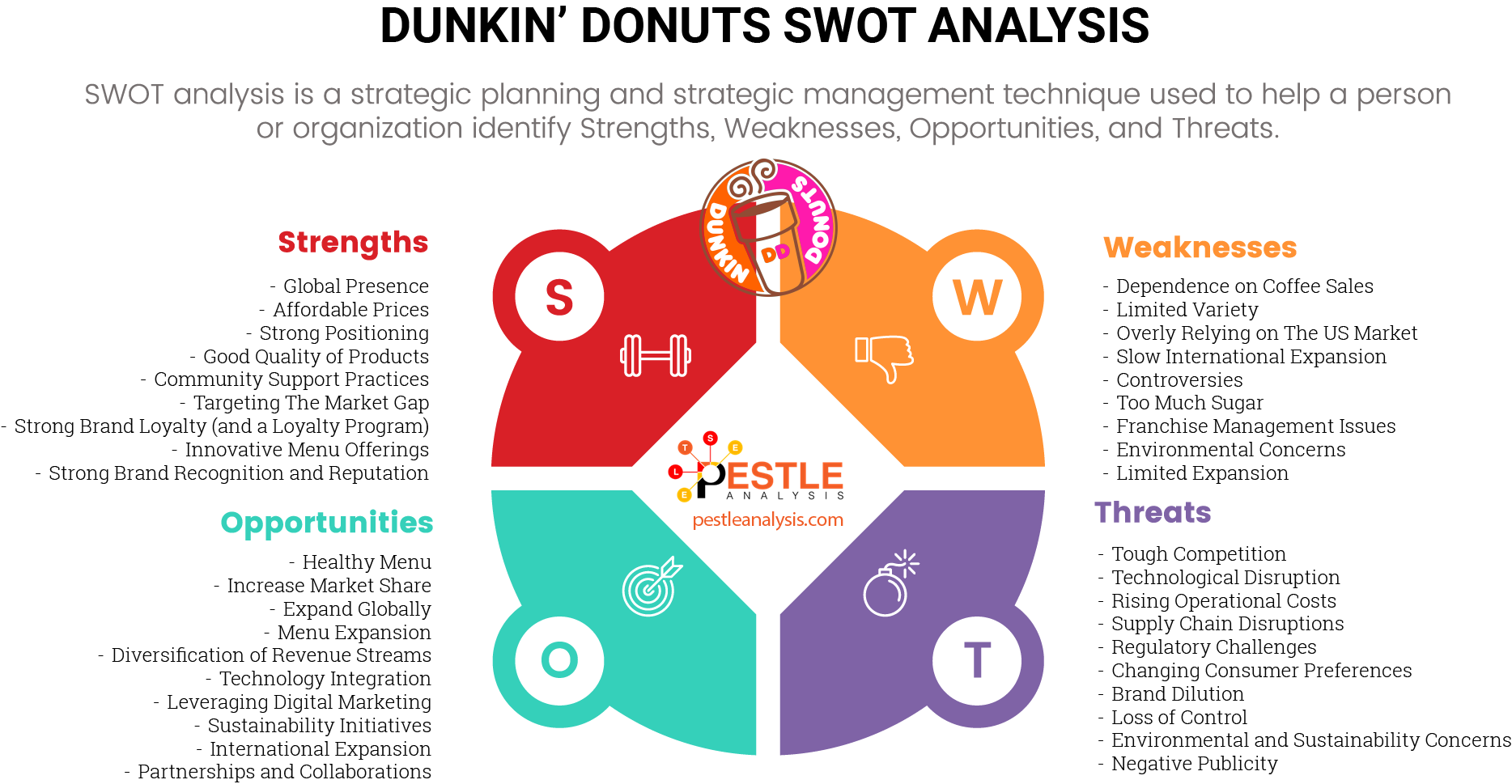Does your morning start with a hot cup of coffee and a donut? If yes, you must be one of many who are crazy about Dunkin' Donuts.
Of course, we all know how famous Dunkin' Donuts is across the globe, but what makes Dunkin' Donuts different from other coffee shops? Is it the flavored coffees, delicious pastries, or juicy sandwiches?
Looking at Dunkin' Donuts' success, we decided to conduct a Dunkin' Donuts SWOT analysis. This article will discuss the strengths, weaknesses, opportunities, and threats faced by Dunkin' Donuts in detail.
Dunkin' Donuts Company Overview

Dunkin' Donuts is considered one of the largest coffee and baked goods chains, with over 13,200 restaurants in 40 countries. It has a near-perfect business combination of private label, quick service restaurant, and locally branded.
If there's a fan-favorite franchise in America, it's Dunkin' Donuts. As of 2024, Dunkin' Donuts operates approximately 9,641 locations across the United States. This number represents a significant increase from previous years, reflecting the company's ongoing expansion efforts to enhance its market presence nationally
In 2023, Dunkin' Donuts generated approximately $1.4 billion in revenue, continuing its growth trajectory from previous years. The company has significantly expanded its market presence, aiming to increase its global market share further. This revenue reflects Dunkin's robust business model and successful strategies in the competitive coffee and baked goods market.

Dunkin' Donuts has achieved enormous growth over the years, but looking at their success, a question arises: how did a donut and coffee shop become a worldwide brand?
To understand this phenomenon, you have to go back to 1946 when William Rosenberg started selling donuts and coffee in Quincy, Massachusetts. Later, in 1950, he opened a shop where he began selling coffee and donuts. Soon, this shop gained popularity, and Rosenberg named his shop Dunkin' Donuts.
Dunkin' Donuts is often known for its coffee and donuts only, but in reality, it has a diverse menu. They offer a wide range of products, from hot drinks, cold drinks, and donuts to muffins, bagels, and sandwiches.
Although Dunkin' Donuts has a diverse menu, if you ask someone, they'll be like, "Dunkin' Donuts is known for its large variety of donuts and coffees."
This is true since it offers 22 different types of donuts and a wide variety of coffees, including Latte, Espresso, Cappuccino, etc. In addition, besides hot drinks, Dunkin' Donuts also has cold beverages such as cold coffees, frozen drinks, iced teas, etc.
Now, let's begin our SWOT analysis, starting with the company's strengths.
Dunkin' Donuts Strengths

Strengths in SWOT analysis tend to be the reasons that help an organization grow. Strengths, after all, are pretty straightforward as they are things that an organization Is good at.
Global Presence
Dunkin' Donuts is on a mission to fuel the world's coffee and donuts cravers. Dunkin' brands are some of the world's most recognized coffee brands, serving quality coffee and delicious baked goods in 40 countries.
Its increasing global presence is a sign of increasing demand for Dunkin' Donuts products.
Affordable Prices
One of Dunkin' Donuts' key strengths is its competitive pricing strategy. Offering quality products at affordable prices makes Dunkin' Donuts accessible to a broad customer base, from students to working professionals. This affordability helps Dunkin' maintain a strong market presence, even in economically challenging times.
When comparing the prices of Dunkin' Donuts and Starbucks over the years, it's evident that Dunkin' generally offers more affordable options.
As of recent comparisons, a large latte at Dunkin' Donuts costs about $2.49, whereas a similar-sized venti latte at Starbucks is priced at $4.15. Similarly, for regular coffee drinks, a 20 oz Venti hot coffee at Starbucks costs $3.25, while a 24 oz XL hot coffee at Dunkin' costs $2.89. This trend of Dunkin' Donuts being cheaper extends to most of their menu items, including food and specialty drinks.
Several factors influence these price differences, including store locations and the overall business models of each chain. Starbucks tends to operate in high-rent areas and offers a more premium cafe experience, which contributes to higher prices. Dunkin' Donuts, on the other hand, focuses on a grab-and-go model, which helps keep their prices lower.
Strong Positioning
Dunkin' Donuts has effectively positioned itself as a convenient, affordable, and high-quality option for coffee and breakfast. This strong market positioning differentiates it from competitors and attracts a wide customer base.
Good Quality of Products
Dunkin' has shown itself to be a company that can deliver. Dunkin' Donuts' delicious products are created with the same passion and care. Dunkin' Donuts decided to have centralized manufacturing locations (CMLs) to ensure consistent product quality.
By doing so, freshly baked donuts and other bakery goods are delivered from centralized manufacturing locations every day, so you get the same delicious taste and quality you expect from Dunkin' Donuts, no matter where you are.
Core Competency in Supply Chain Management
Dunkin' Donuts has developed a robust supply chain management system that ensures the freshness and consistency of its products across all locations. This competency helps maintain product quality and operational efficiency.
Community Support Practices
Donuts, coffee, bagels – we all have a favorite. But our shared favorite is helping people in need and supporting good causes. So other than selling donuts and coffee, Dunkin' Donuts is involved in taking beneficial initiatives for the community.
Dunkin' Donuts has served the community in different ways: helping unemployed people, feeding families during COVID-19, getting cancer patients treated, etc. This not only helped Dunkin' Donuts earn a good name but also increased the brand's customer base.
Targeting The Market Gap
When you think of going out for breakfast, which place comes to your mind? Correct! It's Dunkin' Donuts. For the last 70 years, Dunkin' Donuts has been offering perfect breakfasts to its customers.
By focusing on this niche market, Dunkin' Donuts has earned the reputation of serving one of the best breakfasts worldwide.
Strong Brand Loyalty (and a Loyalty Program)
Dunkin' Donuts enjoys a high level of brand loyalty from its customers. The brand has built a loyal customer base by consistently delivering quality products and exceptional service. This loyalty ensures repeat business and word-of-mouth marketing, which are crucial for sustained growth.
This loyalty is converted into a well-established loyalty program, DD Perks, which rewards customers for their purchases with points that can be redeemed for free beverages and food items. This program not only incentivizes repeat business but also helps the company gather valuable customer data, which can be used to tailor marketing efforts and improve customer experience.
Innovative Menu Offerings
Dunkin' Donuts continually innovates its menu to cater to evolving customer tastes and preferences. From introducing new coffee flavors to offering seasonal and limited-time products, Dunkin' keeps its menu fresh and exciting. This innovation helps attract new customers and retain existing ones, maintaining the brand's competitive edge in the market.
Dunkin' Donuts Weaknesses
If a SWOT analysis only identified strengths, it would not be of much use. However, where it mentions strengths, it also sheds light on the weaknesses of an organization.
This section will highlight some of the weaknesses that hold back Dunkin' Donuts from dominating the market.
Dependence on Coffee Sales
A significant portion of Dunkin' Donuts' revenue comes from coffee sales. This heavy reliance on a single product category can be a vulnerability. Any fluctuations in coffee prices or changes in consumer preferences toward alternative beverages could adversely impact the company's profitability.
Limited Variety
Compared to competitors like Starbucks, Dunkin' Donuts offers a more limited menu variety. Expanding the range of products, especially healthier and more diverse options, could attract a broader customer base.
Overly Relying on The US Market
Remember? Dunkin' Donuts once launched an advertisement campaign with the tagline "America runs on Dunkin'". Well, it is actually true.
Dunkin' Donuts America has found the key to America's morning. In the U.S., Dunkin' Donuts is a brand that thrives within the confines of convenience stores and gas stations.
Almost everywhere in the U.S., you can easily find Dunkin' Donuts. Sales of Dunkin' Donuts within the U.S. contribute a lot to Dunkin' Donuts' total revenue. In fact, in 2019, 46.7% of their total revenue came from the Dunkin' Donuts U.S. segment.
Since almost half of the revenue of Dunkin' Donuts is generated within the U.S., a recession in the U.S. economy can have adverse effects on Dunkin' Donuts.
Slow International Expansion
International expansion is the aim of any brand as it brings a lot of recognition and multiplied profits to the brand. Like other brands, Dunkin' Donuts also stepped out from its land of origin to spread its roots internationally.
Still, Dunkin' Donuts couldn't spread rapidly in other countries for some odd reason. Although Dunkin' Donuts managed to open its branches in 36 countries, that's not enough. On the other hand, its competitor, Starbucks, is present in more than 80 countries.
Controversies
One of the most dangerous things for any business is getting involved in controversies. Controversies damage a company's reputation and can also hurt a business financially.
Dunkin' Donuts has been at the center of some controversial matters. The company has been criticized in the past for having discriminatory behavior based on color and ethnicity.
Too Much Sugar
Let's face it: Donuts are delicious, but they contain a lot of Sugar. When they first started in 1950, people weren't very aware of all the calories and potential diseases sugar can cause.
But In the current era, medical research has unleashed that high sugar intake not only causes obesity it also increases the chances of having heart disease.
Since Dunkin' Donuts primarily focuses on donuts and other sweet bakery items, it is not considered a place with a healthy menu.
Franchise Management Issues
Dunkin' Donuts relies heavily on its franchise model for expansion, which can lead to inconsistent customer experiences across different locations. Managing and maintaining the quality and standards across all franchises can be challenging, and any lapses can negatively impact the brand's reputation and customer loyalty.
Environmental Concerns
Dunkin' Donuts faces scrutiny over its environmental footprint, particularly related to waste generated from disposable cups and packaging. Although the company has made strides towards more sustainable practices, any perceived lag in these efforts could lead to negative publicity and loss of environmentally conscious customers.
Dunkin' Donuts Opportunities

Opportunities are the chances through which an organization can expand. Noting down the chances is a way to identify possible opportunities that an organization may be able to take advantage of.
Many opportunities lie ahead of Dunkin' Donuts through which it can maximize its market share and become the market leader.
Healthy Menu
Dunkin' Donuts' menu desperately needs a healthy option. Instead, Dunkin' Donuts offers notoriously low-quality food such as Donuts and Apple Fritters, usually well over 400 calories.
Dunkin' Donuts has the opportunity to team up with some dieticians and make their menus healthier by adding fruit and vegetables to their breakfast options, introducing sugar-free products, and changing their sides from bagels to apples.
As a result, Dunkin' Donuts will attract more customers and retain current ones who are not looking for pure junk food by improving their menus.
Increase Market Share
Dunkin Donuts could increase its market share to increase its revenue. Moreover, this is the right time since earnings increase, and consumers are more willing to try new products. Since Dunkin' Donuts is already a very famous brand, it just needs some strategic and tactical changes in its policies to get its expansion going.
Expand Globally
While Dunkin' Donuts has a presence in 40 countries, there is ample opportunity for further international expansion. Targeting emerging markets in Asia, Africa, and South America where the demand for quick-service restaurants is growing can help increase market share. Tailoring products to local tastes and preferences will be crucial for success in these regions.
Menu Expansion
A quick glimpse at the donut and coffee industry shows that coffee shops such as Starbucks and Second Cup are continually expanding their menu. As a result, consumers pay a premium for a quality product.
Dunkin' Donuts currently only offers limited choices; however, if they were to expand their menu to include salads and meals for lunch and dinner, this would likely increase the overall consumption of their products.
Expanding into new food product categories, such as healthy snacks, plant-based options, and gourmet beverages, can attract new customers and meet evolving consumer preferences.
Diversification of Revenue Streams
The quintessential American brand, Dunkin' Donut, could use its brand popularity to move into the juice market or diversify by becoming a cereal manufacturer.
By doing so, Dunkin' Donuts can widen its revenue channel. A diversification strategy will decrease the reliance on the current business and make the existing business more profitable.
Technology Integration
Embracing technology can provide significant opportunities for Dunkin' Donuts. Implementing advanced mobile ordering and payment systems, leveraging data analytics to understand customer preferences, and using AI for personalized marketing can enhance customer experience and operational efficiency.
Leveraging Digital Marketing
In the digital age, Dunkin' Donuts has significant opportunities to expand its reach through digital marketing. Utilizing social media platforms, influencer partnerships, and targeted online advertising can attract new customers and engage existing ones. Additionally, enhancing their mobile app with personalized offers and seamless ordering options can improve customer loyalty and satisfaction.
Sustainability Initiatives
With growing consumer awareness about environmental issues, Dunkin' Donuts can capitalize on this trend by adopting more sustainable practices. This includes using eco-friendly packaging, sourcing ethically produced ingredients, and reducing waste. Highlighting these initiatives can attract environmentally conscious consumers and enhance the brand's reputation.
International Expansion
Despite its presence in 40 countries, Dunkin' Donuts can further expand into emerging markets with high growth potential. By tailoring its products to local tastes and preferences, Dunkin' can capture new customer segments and increase its global footprint.
Partnerships and Collaborations
Dunkin' Donuts can explore partnerships with other popular brands, influencers, or food delivery services to reach a broader audience. Collaborations can lead to innovative product offerings and marketing campaigns that attract new customers and create buzz around the brand.
Dunkin' Donuts Threats

This is the last section of the SWOT analysis. This section includes the threats that Dunkin' Donuts will face externally. Threats are the things that could harm your business. In the Dunkin' Donuts case, we will discuss the factors which could harm Dunkin' Donuts.
Tough Competition
The fried dough business is not all wavy cobs and sprinkles but rather a tough battle between donut and coffee chains.
The quick-service restaurant industry is highly competitive, with major players like McDonald's, Starbucks and local cafes constantly innovating and expanding. Dunkin' Donuts needs to continuously improve and innovate to maintain its competitive edge.
Although Dunkin' Donuts has a great breakfast menu and excellent coffee, it has a steep hill to climb if it wants to be the industry's new leader.
Technological Disruption
Rapid advancements in technology pose a threat to traditional business models. Competitors leveraging advanced technologies for personalized marketing, efficient operations, or enhanced customer experiences could outpace Dunkin' Donuts if it fails to keep up. Investing in technology to improve digital ordering, delivery services, and customer engagement is essential to remain competitive.
Rising Operational Costs
Increasing costs of raw materials, labor, and transportation can significantly impact Dunkin' Donuts' profitability. Inflation and fluctuations in commodity prices, such as coffee and sugar, may result in higher production costs that are difficult to pass on to consumers without affecting demand.
Dunkin' Donuts must manage these costs effectively to remain competitive in pricing.
Health Crises and Global Health Trends
Dunkin' Donuts faces potential threats from future health crises and evolving global health trends.
The COVID-19 pandemic highlighted the vulnerability of businesses to sudden economic disruptions, resulting in significant financial losses and the closure of 800 stores in the U.S. Future pandemics or widespread health emergencies could similarly impact operations, supply chains, and consumer behavior.
Supply Chain Disruptions
Dunkin' Donuts relies on a complex supply chain for its ingredients and products. Natural disasters, geopolitical tensions, or transportation issues can disrupt this supply chain, leading to shortages, increased costs, and potential loss of sales.
Regulatory Challenges
The food and beverage industry is subject to stringent regulations and compliance requirements. Changes in health and safety regulations, labor laws, or environmental standards can pose operational challenges and increase compliance costs for Dunkin' Donuts.
Changing Consumer Preferences
Consumer tastes and preferences are constantly evolving.
A shift towards healthier eating habits, plant-based diets, or sustainable food sources can reduce the demand for traditional products offered by Dunkin' Donuts, requiring significant adjustments to the menu and sourcing practices.
The fact that most of the products sold by Dunkin' Donuts are deep-fried and served with sugar will eventually make people stay away from them.
Brand Dilution
Over-expansion or aggressive franchising can lead to brand dilution. If Dunkin' Donuts opens too many locations too quickly, especially in markets that are not yet mature, it risks saturating the market and reducing the perceived value and exclusivity of the brand.
Loss of Control
With a large number of franchise locations, maintaining consistent quality and service standards can be challenging. Any lapses can negatively impact the brand's reputation and customer trust.
Environmental and Sustainability Concerns
As consumers become more environmentally conscious, Dunkin' Donuts may face pressure to adopt more sustainable practices. Failure to address concerns about packaging waste, energy consumption, and sustainable sourcing can result in negative publicity and loss of customer trust.
Negative Publicity
Negative publicity, whether due to food safety concerns, labor issues, or environmental criticisms, can severely damage Dunkin' Donuts' reputation. In today's digital age, news spreads quickly, and any negative incident can lead to a significant backlash, impacting customer trust and sales. Proactive public relations and crisis management strategies are vital to mitigate this risk.
This concludes all four parts of the SWOT analysis. Let's see how a manager can take action based on today's analysis.
Recommendations on Dunkin' Donuts SWOT Analysis

Here are 8 key actionable tips based on today's SWOT analysis of Dunkin' Donuts for the company, so that it capitalizes on its strengths and addresses its weaknesses:
- Leverage strong brand recognition to enter new markets and enhance the DD Perks loyalty program to boost customer retention.
- Diversify product offerings to include more healthy options and accelerate international expansion to reduce reliance on the US market.
- Improve franchise management by implementing comprehensive training and support programs for franchisees.
- Invest in digital marketing and sustainability initiatives to attract tech-savvy and environmentally conscious consumers.
- Stay ahead of technological disruptions by integrating AI and data analytics into operations and continuously updating the mobile app and website.
- Manage supply chain disruptions by developing contingency plans and diversifying suppliers.
- Implement cost-control measures to address rising operational costs.
- Stay informed about regulatory changes and proactively adapt to new regulations.
Dunkin' Donuts Competitors
To get the full picture of how Dunkin' Donuts stacks up, it's super important to check out the SWOT analyses of some of its biggest competitors. This way, you'll get a clear idea of how each company is doing and how they're handling all the trends and changes in the industry.
Here are a few key ones to look at:
- SWOT analysis of Starbucks
- SWOT analysis of McDonald's
- SWOT analysis of Costa Coffee
- PESTLE analysis of Subway
- SWOT analysis of Panera Bread
Digging into these will give you some awesome insights into the market. Whether you're just curious, doing a school project, or thinking about investing one day, this kind of analysis can be really eye-opening.








